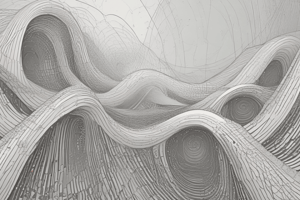Podcast
Questions and Answers
What is the determinant of the matrix ( \begin{bmatrix} 2 & -2 \ 4 & -3 \end{bmatrix} )?
What is the determinant of the matrix ( \begin{bmatrix} 2 & -2 \ 4 & -3 \end{bmatrix} )?
- 2
- -2 (correct)
- 3
- 11
Which of the following statements is NOT a property of determinants?
Which of the following statements is NOT a property of determinants?
- The determinant is zero if any two rows are identical.
- The determinant is unchanged when a row is added to another row. (correct)
- The determinant of a product is the product of the determinants.
- The determinant changes sign when two rows are swapped.
Which theorem states that every square matrix satisfies its own characteristic polynomial?
Which theorem states that every square matrix satisfies its own characteristic polynomial?
- Cayley-Hamilton Theorem (correct)
- Cauchy-Schwarz Theorem
- Lagrange's Theorem
- Rouché's Theorem
What is the characteristic polynomial of the matrix ( A = \begin{bmatrix} 1 & 2 \ 2 & 1 \end{bmatrix} )?
What is the characteristic polynomial of the matrix ( A = \begin{bmatrix} 1 & 2 \ 2 & 1 \end{bmatrix} )?
If the rank of matrix A is less than its number of columns, what can be concluded?
If the rank of matrix A is less than its number of columns, what can be concluded?
What are Eigenvalues?
What are Eigenvalues?
What is the sum of the Eigenvalues of the matrix ( \begin{bmatrix} 2 & -2 \ 4 & -3 \end{bmatrix} )?
What is the sum of the Eigenvalues of the matrix ( \begin{bmatrix} 2 & -2 \ 4 & -3 \end{bmatrix} )?
What represents a major application of matrices in real life?
What represents a major application of matrices in real life?
Which statement correctly defines the concept of rank in linear algebra?
Which statement correctly defines the concept of rank in linear algebra?
Which of the following statements describes a vector subspace?
Which of the following statements describes a vector subspace?
What does linear independence of a set of vectors imply?
What does linear independence of a set of vectors imply?
Which of the following equations defines a Linear Transformation?
Which of the following equations defines a Linear Transformation?
In the context of Cayley-Hamilton theorem, what does the theorem state about a square matrix?
In the context of Cayley-Hamilton theorem, what does the theorem state about a square matrix?
Which of the following best describes the dimension of a vector space?
Which of the following best describes the dimension of a vector space?
For a given linear system, what does the term homogeneous refer to?
For a given linear system, what does the term homogeneous refer to?
If a matrix has a nullity of 3, what can be inferred about its rank?
If a matrix has a nullity of 3, what can be inferred about its rank?
What does Sylvester's Law (Rank and Nullity Theorem) describe?
What does Sylvester's Law (Rank and Nullity Theorem) describe?
Is the set S = {(1, 1), (1, -1)} a basis of R²?
Is the set S = {(1, 1), (1, -1)} a basis of R²?
Which condition must be satisfied for the union of two subspaces U and V to be a subspace of a vector space?
Which condition must be satisfied for the union of two subspaces U and V to be a subspace of a vector space?
If V is a vector space over a field F, what can be stated about the set Fv which consists of all scalar multiples of a vector v?
If V is a vector space over a field F, what can be stated about the set Fv which consists of all scalar multiples of a vector v?
Which of the following describes a linear combination of vectors?
Which of the following describes a linear combination of vectors?
What is the dimension of the vector space whose basis is { (2,4,6), (0,5,6), (0, 6,6)}?
What is the dimension of the vector space whose basis is { (2,4,6), (0,5,6), (0, 6,6)}?
In a vector space V3, which set of vectors is likely to be linearly independent?
In a vector space V3, which set of vectors is likely to be linearly independent?
Which of the following statements is true regarding the mapping t: R³ -> R³ defined by t(a, b, c) = (a, b, 0)?
Which of the following statements is true regarding the mapping t: R³ -> R³ defined by t(a, b, c) = (a, b, 0)?
Flashcards
Vector Space Definition
Vector Space Definition
A set of vectors with operations of addition and scalar multiplication, satisfying specific properties (closure, associativity, commutativity, distributivity, identity, inverse).
Vector Subspace Definition
Vector Subspace Definition
A subset of a vector space that is also a vector space under the same operations, it must contain the zero vector.
Linear Combination of Vectors
Linear Combination of Vectors
A vector formed by multiplying vectors by scalars and adding the results.
Linear Span of Vectors
Linear Span of Vectors
Signup and view all the flashcards
Basis of a Vector Space
Basis of a Vector Space
Signup and view all the flashcards
Linear Transformation Definition
Linear Transformation Definition
Signup and view all the flashcards
Dimension of a Vector Space
Dimension of a Vector Space
Signup and view all the flashcards
Linear Independence of Vectors
Linear Independence of Vectors
Signup and view all the flashcards
Rank-Nullity Theorem
Rank-Nullity Theorem
Signup and view all the flashcards
Vector Subspace
Vector Subspace
Signup and view all the flashcards
Zero Vector Space
Zero Vector Space
Signup and view all the flashcards
Matrix: Vector Space?
Matrix: Vector Space?
Signup and view all the flashcards
R and R^n
R and R^n
Signup and view all the flashcards
Properties of Vector Space
Properties of Vector Space
Signup and view all the flashcards
Union of Subspaces: Subspace?
Union of Subspaces: Subspace?
Signup and view all the flashcards
What is a matrix?
What is a matrix?
Signup and view all the flashcards
Determinant of a Matrix
Determinant of a Matrix
Signup and view all the flashcards
Rank of a matrix
Rank of a matrix
Signup and view all the flashcards
Cayley-Hamilton Theorem
Cayley-Hamilton Theorem
Signup and view all the flashcards
Eigenvalue
Eigenvalue
Signup and view all the flashcards
Eigenvector
Eigenvector
Signup and view all the flashcards
Characteristic polynomial
Characteristic polynomial
Signup and view all the flashcards
Green's Theorem
Green's Theorem
Signup and view all the flashcards
Study Notes
Course Information
- Course Name: Calculus & Linear Algebra
- Course Code: 21BTBS101
- Faculty: MOHD SAGID ALI
- Semester: FIRST
- Session: 2023-2024
- Question Bank (Unit 1)
Unit 1 (Calculus) - 2 Marks Questions
- State Rolle's, Lagrange's Mean Value theorem
- Write Maclaurin's series
- Is the Rolle's theorem applicable to function tanx in (0,π/2)?
- Can Rolle's theorem be applied to secx for [0, π]?
- Write Euler's theorem
- Write the geometrical meaning of Lagrange's Mean Value theorem
- Write the geometrical meaning of Rolle's theorem
- What is the meaning of partial derivative
- Verify that (x^2/4 + y^4/4) / (x^1/5 + y^1/5) is a homogeneous function and find its degree
- State Cauchy's mean value theorem
- If x = acos³θ, y = bsin³θ, find (d²y/dx²)
- How do you calculate maxima and minima of two variables x and y?
- State all the derivatives involve in z = f(x, y)
- If u = (x - y)² + (y − z)⁴ + (z – x)⁴, then find the value of (∂u/∂x) + (∂u/∂y) + (∂u/∂z)
- Explain the graph given below which is related to Lagrange's mean value theorem
Unit 1 (Calculus) - 5 Marks Questions
- verify langrange's theorem for the function f(x) = x(x-1)(x-2) in (0, 1/2) also find the value of c
- Test x³ + y³ - 63(x + y) + 12xy for extrema points
- Discuss the Maxima and Minima of the function 2(x² - y²) - x⁴ + y⁴
- Expand the function f(x) =sinx about x=π/6 according to taylor series
- verify Rolle's theorem and find the value of c. f(x) = x² - 8x + 5, [2,6]
- Expand cosx by Taylor's theorem in powers of (x - π/4) upto fourth degree and find the coefficient of the last term.
- If r² = x² + y², prove that (∂²r/∂x²) + (1/r) (∂r/∂x)²=(∂²r/∂y²) + (1/r)(∂r/∂y)²
- Find (∂²z/∂x∂y) and (∂²z/∂y∂x) for the following function x² sin(y³) + xe³z - cos(z²) = 3y - 6z + 8
- Expand √x by Taylor's theorem about point x=1 upto third degree. Hence find the value of √10
- If z = x³ + y³ – 3axy, show that (∂²z/∂x∂y) = (∂²z/∂y∂x)
- Let u = log(x² + y² + z²)¹/², then find (∂²u/∂x²)+(∂²u/∂y²)+(∂²u/∂z²)
- Discuss the maxima and minima of x³ + y³ – 12x – 3y + 20
- Find (df/dx) and (df/dy) for the following functions
- f(x,y) = (xy – 1)²
- f(x,y) = 1/(x+y)
- f(x,y) = ln(x+y)
- f(x,y) = sin²(x - 3y)
- f(x,y) = xy
- Find the maximum and minimum values of f(x, y) = x² + 3xy² - 15x² - 15y² + 72x
- What is homogeneous function and state Euler's theorem in Partial derivatives
- Write working rule to find the maximum and minimum values of two variable function f(x, y)
- Find the first 3 terms in the Maclaurin series for (a) sin²x, (b) √(1−x²)
Unit 2 (Integral Calculus)
- Find the area of ellipse (x²/a²) + (y²/b²) = 1
- Find by double integration the area between y = x² and y = x
- Evaluate ∫∫xy²dxdy (limits)
- Evaluate ∫∫(x+y)dxdy (limits)
- Evaluate ∫∫e^(x+y)dxdy (limits)
- Evaluate ∫∫(x² + y²)dxdy (limits)
- Evaluate ∫∫xyzdxdydz (limits)
- Give physical interpretation of double integral
- Give physical interpretation of triple integral
- What is change of order of integration?
- How do you calculate the area bounded by curves by double integration?
- How do you calculate the volume of solids in double integral and in triple integral
Unit 3 (Vector Calculus)
- State Gauss Theorem
- State Green's Theorem
- State Stoke's Theorem
- Define scalar and vector point functions
- Give examples of scalar and vector field
- Define gradient of a scalar field
- What do you mean by divergence of vector field
- Give geometric interpretation of gradient
- Write physical interpretation of divergence.
- Define curl of vector F
- What is the condition for irrotational vector?
- When is a force said to be conservative.
- If (x, y, z) = 3x²y-y³z², find ∇ø and |∇ ø| at (1, -2, -1)
- Find a unit normal to the surface x²y + 2xz = 4 at the point (2, -2, 3)
- Find the directional derivative of f = xyz² + 4xz² at (1, -2, -1) in the direction 2i – j-2k
- Evaluate divergence of Ā = 2x²zi - xy²zj+3yz²k at the point (1, 1, 1)
Additional Information for Question Banks
- Question Bank Units(2-3 questions are mentioned): Unit 02, Unit 03
- Further multiple choice questions are also included in Question Banks, and section (A, B, and C)
Matrix and Determinants
- Information on Matrices and Determinants, their applications, Rank, Cayley-Hamilton Theorem, Eigenvalues, Eigenvectors, Characteristic Polynomial of a Matrix.
- Problems involving the mentioned concepts and finding the characteristic equation for a matrix.
- Solving for the consistency and solution of systems of equations.
Studying That Suits You
Use AI to generate personalized quizzes and flashcards to suit your learning preferences.





